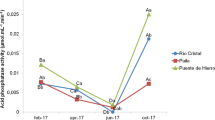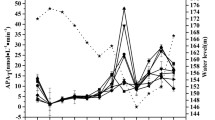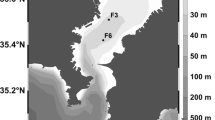Abstract
Carbon, nitrogen and phosphorus inputs through atmospheric deposition, surface runoff and point sources were measured in the Ganga River along a gradient of increasing human pressure. Productivity variables (chlorophyll a, gross primary productivity, biogenic silica and autotrophic index) and heterotrophy (respiration, substrate induced respiration, biological oxygen demand and fluorescein diacetate hydrolysis) showed positive relationships with these inputs. Alkaline phosphatase (AP), however, showed an opposite trend. Because AP is negatively influenced by available P, and eutrophy generates a feedback on P fertilization, the study implies that the alkaline phosphatase can be used as a high quality criterion for assessing river health.






Similar content being viewed by others
References
APHA (1998) Standard methods for the examination of water and wastewater. American Public Health Association, Washington, DC
Bidle KD, Azam F (1999) Accelerated dissolution of diatom silica by marine bacterial assemblages. Nature 397:508–512
Castillo MM, Kling GW, Allan JD (2003) Bottom-up controls on bacterial production in tropical lowland rivers. Limnol Oceanogr 48:1466–1475
Costa AL, Paixão SM, Caçador I, Carolino M (2007) CLPP and EEA profiles of microbial communities in salt marsh sediments. J Soil Sediments 7:418–425
Duhamel S, Dyhrman ST, Karl DM (2010) Alkaline phosphatase activity and regulation in the North Pacific subtropical gyre. Limnol Oceanogr 55(3):1414–1425
Dyhrman ST, Chappell PD, Haley ST, Moffett JW, Orchard ED, Waterbury JB, Webb EA (2006) Phosphonate utilization by the globally important marine diazotroph Trichodesmium. Nature 439:68–71
Gibbons SM, Jones E, Bearquiver A, Blackwolf F et al (2014) Human and environmental impacts on river sediment microbial communities. PLoS ONE 9(5):e97435. doi:10.13771/0097435
Lafont M (2001) A conceptual approach to the biomonitoring of freshwater: the ecological ambience system. J Limnol 60(Suppl. 1):17–24
Lau DCP, Leung KMY, Dudgeon D (2009) What does stable isotope analysis reveal about trophic relationships and the relative importance of allochthonous and autochthonous resources in tropical streams? a synthetic study from Hong Kong. Freshw Biol 54:127–141
Maiti SK (2001) Handbook of methods in environmental studies. Water and wastewater, vol 1. ABD, Jaipur
Mhamdi BA, Azzouzi A, Elloumi J, Ayadi H, Mhamdi MA, Aleya L (2007) Exchange potentials of phosphorus between sediments and water coupled to alkaline phosphatase activity and environmental factors in an oligo-mesotrophic reservoir. Compte Reus Biol 330: 419–428
Michel P (1984) Ecological methods for field and laboratory investigation. Tata McGraw-Hill Publishing Company, New Delhi
Newman S, Reddy KR (1993) Alkaline phosphatase activity in the sediment-water column of a hypereutrophic lake. J Environ Qual 22:832–838
Pandey J, Pandey U, Singh AV (2014) Impact of changing atmospheric deposition chemistry on carbon and nutrient loading to Ganga River: Integrating land–atmosphere–water components to uncover cross-domain carbon linkages. Biogeochemistry 14:179–198
Pandey J, Pandey U, Singh AV, Tripathi S, Mishra V (2016) Atmospheric N and P deposition in the Ganges basin. Curr Sci 110:974–976
Pearson CE, Ormerod SJ, Symondson WO, Vaughan IP (2016) Resolving large-scale pressures on species and ecosystems: propensity modelling identifies agricultural effects on streams. J Appl Ecol 53(2):408–417
Ponader KC, Charles DF, Belton TJ, Winter DM (2008) Total phosphorus inference models and indices for coastal plain streams based on benthic diatom assemblage from artificial substrates. Hydrobiologia 610:139–152
Sayler GS, Puziss M, Silver M (1979) Alkaline phosphatase assay for freshwater sediments: application to perturbed sediment systems. Appl Environ Microbiol 38(5):922–927
Schinegger R, Trautwein C, Melcher A, Schmutz S (2012) Multiple human pressures and their spatial patterns in European running waters. Water Environ J 26(2):261–273
Schnurer J, Rosswall T (1982) Fluorescein diacetate hydrolysis as a measure of total microbial activity in the soil and litter. Appl Environ Microbiol 43:1256–1261
Sinsabaugh RL, Hill BH, Shah JJF (2009) Ecoenzymatic stoichiometry of microbial organic nutrient acquisition in soil and sediment. Nature 462:795–798
Stevenson RJ, Bennett BJ, Jordan DN, French RD (2012) Phosphorus regulates stream injury by filamentous green algae, DO, and pH with thresholds in responses. Hydrobiologia 695:25–42
Tabatabai MA, Bremner JM (1969) Use of p- nitrophenyl phosphate for assay of soil phosphatase activity. Soil Biol Biochem 1:301–307
Turley MD, Bilotta GS, Chadd RP, Extence CA, Brazier RE, Burnside NG, Pickwell AGG (2016) A sediment-specific family-level biomonitoring tool to identify the impacts of fine sediment in temperate rivers and streams. Ecol Indic 70:151–165
Voghel AI (1971) A text book of quantitative inorganic analysis, 4th edn. The English Language Book Society, Longman, Essex
Wahl MH, Mckellar HM, Williams TM (1997) Patterns of nutrient loading in forested and urbanized coastal streams. J Exp Mar Biol Ecol 213:111–131
Wardle DA, Yeates GW, Watson RN, Nicholson KS (1993) Response of soil microbial biomass and plant litter decomposition in maize and Asparagus cropping systems. Soil Biol Biochem 25:857–868
Acknowledgements
The authors are thankful to the Coordinator, Centre of Advanced Study in Botany, Banaras Hindu University for facilities and to Banaras Hindu University-University Grants Commission, New Delhi for funding support as fellowship to A.Y.
Author information
Authors and Affiliations
Corresponding author
Rights and permissions
About this article
Cite this article
Yadav, A., Pandey, J. Water Quality Interaction with Alkaline Phosphatase in the Ganga River: Implications for River Health. Bull Environ Contam Toxicol 99, 75–82 (2017). https://doi.org/10.1007/s00128-017-2108-4
Received:
Accepted:
Published:
Issue Date:
DOI: https://doi.org/10.1007/s00128-017-2108-4




